7.09.2020
Primary Mirror for NASA’s Roman Space Telescope Completed

The Nancy Grace Roman Space Telescope’s primary mirror, which will collect and focus light from cosmic objects near and far, has been completed. Using this mirror, Roman will capture stunning space vistas with a field of view 100 times greater than Hubble images.
“Achieving this milestone is very exciting,” said Scott Smith, Roman telescope manager at NASA’s Goddard Space Flight Center in Greenbelt, Maryland. “Success relies on a team with each person doing their part, and it’s especially true in our current challenging environment. Everyone plays a role in collecting that first image and answering inspiring questions.”
Roman will peer through dust and across vast stretches of space and time to study the universe using infrared light, which human eyes can’t see. The amount of detail these observations will reveal is directly related to the size of the telescope’s mirror, since a larger surface gathers more light and measures finer features.
Roman’s primary mirror is 7.9 feet (2.4 meters) across. While it’s the same size as the Hubble Space Telescope’s main mirror, it is less than one-fourth the weight. Roman’s mirror weighs only 410 pounds (186 kilograms) thanks to major improvements in technology.
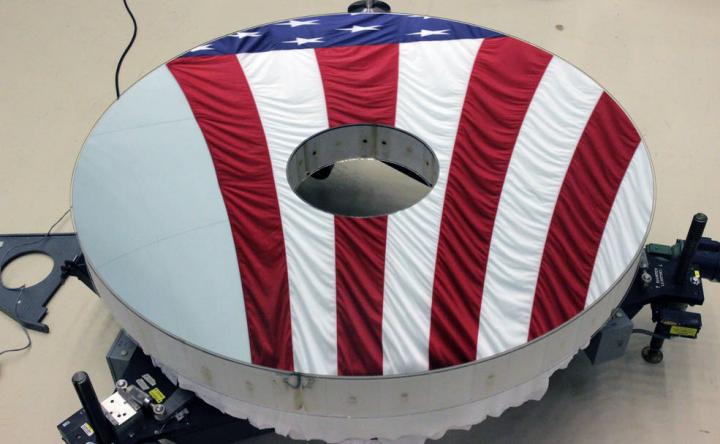
The primary mirror, in concert with other optics, will send light to Roman’s two science instruments – the Wide Field Instrument and Coronagraph Instrument. The first is essentially a giant 300-megapixel camera that provides the same sharp resolution as Hubble across nearly 100 times the field of view. Using this instrument, scientists will be able to map the structure and distribution of invisible dark matter, study planetary systems around other stars, and explore how the universe evolved to its present state.
The coronagraph demonstrates technology that blocks out the glare of stars and allows astronomers to directly image planets in orbit around them. If the coronagraph technology performs as anticipated, it will see planets that are almost a billion times fainter than their host star and enable detailed studies of giant planets around other suns.
Roman will observe from a vantage point about 930,000 miles (1.5 million km) away from Earth in the direction opposite the Sun. Roman’s barrel-like shape will help block out unwanted light from the Sun, Earth, and Moon, and the spacecraft’s distant location will help keep the instruments cool, ensuring that it will be able to detect faint infrared signals.
Because it will experience a range of temperatures between manufacture and testing on Earth and operations in space, the primary mirror is made of a specialty ultralow-expansion glass. Most materials expand and contract when temperatures change, but if the primary mirror changed shape it would distort the images from the telescope. Roman’s mirror and its support structure are designed to reduce flexing, which will preserve the quality of its observations.

Development of the mirror is much further along than it would typically be at this stage since the mission leverages a mirror that was transferred to NASA from the National Reconnaissance Office. The team modified the mirror’s shape and surface to meet Roman’s science objectives.
The newly resurfaced mirror sports a layer of silver less than 400 nanometers thick – about 200 times thinner than a human hair. The silver coating was specifically chosen for Roman because of how well it reflects near-infrared light. By contrast, Hubble’s mirror is coated with layers of aluminum and magnesium fluoride to optimize visible and ultraviolet light reflectivity. Likewise, the James Webb Space Telescope’s mirrors have a gold coating to suit its longer wavelength infrared observations.
Roman’s mirror is so finely polished that the average bump on its surface is only 1.2 nanometers tall – more than twice as smooth as the mission requires. If the mirror were scaled to be Earth’s size, these bumps would be just a quarter of an inch high.
“The mirror was precisely finished to the Roman Space Telescope’s optical prescription,” said Bonnie Patterson, program manager at L3Harris Technologies in Rochester, New York. “Since it’s so much smoother than required, it will provide even greater scientific benefit than originally planned.”
Next, the mirror will be mounted for additional testing at L3Harris. It has already been extensively tested at both cold and ambient temperatures. The new tests will be done with the mirror attached to its support structure.
“Roman’s primary mirror is complete, yet our work isn’t over,” said Smith. “We’re excited to see this mission through to launch and beyond, and eager to witness the wonders it will reveal.”
The Nancy Grace Roman Space Telescope is managed at Goddard, with participation by NASA's Jet Propulsion Laboratory and Caltech/IPAC in Pasadena, California, the Space Telescope Science Institute in Baltimore, and a science team comprising scientists from research institutions across the United States.
Quelle: NASA
----
Update: 27.01.2021
.
When it launches in the mid-2020s, NASA’s Nancy Grace Roman Space Telescope will explore an expansive range of infrared astrophysics topics. One eagerly anticipated survey will use a gravitational effect called microlensing to reveal thousands of worlds that are similar to the planets in our solar system. Now, a new study shows that the same survey will also unveil more extreme planets and planet-like bodies in the heart of the Milky Way galaxy, thanks to their gravitational tug on the stars they orbit.
“We were thrilled to discover that Roman will be able to offer even more information about the planets throughout our galaxy than originally planned,” said Shota Miyazaki, a graduate student at Osaka University in Japan who led the study. “It will be very exciting to learn more about a new, unstudied batch of worlds.”
Roman will primarily use the gravitational microlensing detection method to discover exoplanets – planets beyond our solar system. When a massive object, such as a star, crosses in front of a more distant star from our vantage point, light from the farther star will bend as it travels through the curved space-time around the nearer one.
The result is that the closer star acts as a natural lens, magnifying light from the background star. Planets orbiting the lens star can produce a similar effect on a smaller scale, so astronomers aim to detect them by analyzing light from the farther star.
Since this method is sensitive to planets as small as Mars with a wide range of orbits, scientists expect Roman’s microlensing survey to unveil analogs of nearly every planet in our solar system. Miyazaki and his colleagues have shown that the survey also has the power to reveal more exotic worlds – giant planets in tiny orbits, known as hot Jupiters, and so-called “failed stars,” known as brown dwarfs, which are not massive enough to power themselves by fusion the way stars do.
This new study shows that Roman will be able to detect these objects orbiting the more distant stars in microlensing events, in addition to finding planets orbiting the nearer (lensing) stars.
The team’s findings are published in The Astronomical Journal.
Astronomers see a microlensing event as a temporary brightening of the distant star, which peaks when the stars are nearly perfectly aligned. Miyazaki and his team found that in some cases, scientists will also be able to detect a periodic, slight variation in the lensed starlight caused by the motion of planets orbiting the farther star during a microlensing event.
As a planet moves around its host star, it exerts a tiny gravitational tug that shifts the star’s position a bit. This can pull the distant star closer and farther from a perfect alignment. Since the nearer star acts as a natural lens, it’s like the distant star’s light will be pulled slightly in and out of focus by the orbiting planet. By picking out little shudders in the starlight, astronomers will be able to infer the presence of planets.
“It’s called the xallarap effect, which is parallax spelled backward. Parallax relies on motion of the observer – Earth moving around the Sun – to produce a change in the alignment between the distant source star, the closer lens star and the observer. Xallarap works the opposite way, modifying the alignment due to the motion of the source,” said David Bennett, who leads the gravitational microlensing group at NASA’s Goddard Space Flight Center in Greenbelt, Maryland.
While microlensing is generally best suited to finding worlds farther from their star than Venus is from the Sun, the xallarap effect works best with very massive planets in small orbits, since they make their host star move the most. Revealing more distant planets will also allow us to probe a different population of worlds.
Mining the core of the galaxy
Most of the first few hundred exoplanets discovered in our galaxy had masses hundreds of times greater than Earth’s. Unlike the giant planets in our solar system, which take 12 to 165 years to orbit the Sun, these newfound worlds whirl around their host stars in as little as a few days.
These planets, now known as hot Jupiters due to their giant size and the intense heat from their host stars, weren’t expected from existing planetary formation models and forced astronomers to rethink them. Now there are several theories that attempt to explain why hot Jupiters exist, but we still aren’t sure which – if any – is correct. Roman’s observations should reveal new clues.
Even more massive than hot Jupiters, brown dwarfs range from about 4,000 to 25,000 times Earth’s mass. They’re too heavy to be characterized as planets, but not quite massive enough to undergo nuclear fusion in their cores like stars.
Other planet-hunting missions have primarily searched for new worlds relatively nearby, up to a few thousand light-years away. Close proximity makes more detailed studies possible. However, astronomers think that studying bodies close to our galaxy’s core may yield new insight into how planetary systems evolve. Miyazaki and his team estimate that Roman will find around 10 hot Jupiters and 30 brown dwarfs nearer to the center of the galaxy using the xallarap effect.
The center of the galaxy is populated mainly with stars that formed around 10 billion years ago. Studying planets around such old stars could help us understand whether hot Jupiters form so close to their stars, or are born farther away and migrate inward over time. Astronomers will be able to see if hot Jupiters can maintain such small orbits for long periods of time by seeing how frequently they’re found around ancient stars.
Unlike stars in the galaxy’s disk, which typically roam the Milky Way at comfortable distances from one another, stars near the core are packed much closer together. Roman could reveal whether having so many stars so close to each other affects orbiting planets. If a star passes close to a planetary system, its gravity could pull planets out of their usual orbits.
Supernovae are also more common near the center of the galaxy. These catastrophic events are so intense that they can forge new elements, which are spewed into the surrounding area as the exploding stars die. Astronomers think this might affect planet formation. Finding worlds in this region could help us understand more about the factors that influence the planet-building process.
Roman will open up a window into the distant past by looking at older stars and planets. The mission will also help us explore whether brown dwarfs form as easily near the center of the galaxy as they do closer to Earth by comparing how frequently they’re found in each region.
By tallying up very old hot Jupiters and brown dwarfs using the xallarap effect and finding more familiar worlds using microlensing, Roman will bring us another step closer to understanding our place in the cosmos.
“We’ve found a lot of planetary systems that seem strange compared with ours, but it’s still not clear whether they’re the oddballs or we are,” said Samson Johnson, a graduate student at Ohio State University in Columbus and a co-author of the paper. “Roman will help us figure it out, while helping answer other big questions in astrophysics.”
The Nancy Grace Roman Space Telescope is managed at NASA’s Goddard Space Flight Center in Greenbelt, with participation by NASA's Jet Propulsion Laboratory and Caltech/IPAC in Pasadena, California, the Space Telescope Science Institute in Baltimore, and a science team comprising scientists from various research institutions. The primary industrial partners are Ball Aerospace and Technologies Corporation in Boulder, Colorado, L3Harris Technologies in Melbourne, Florida, and Teledyne Scientific & Imaging in Thousand Oaks, California.
Quelle: NASA
----
Update: 5.10.2022
-
NASA’s Roman Mission Delivers Detectors to Japan’s PRIME Telescope
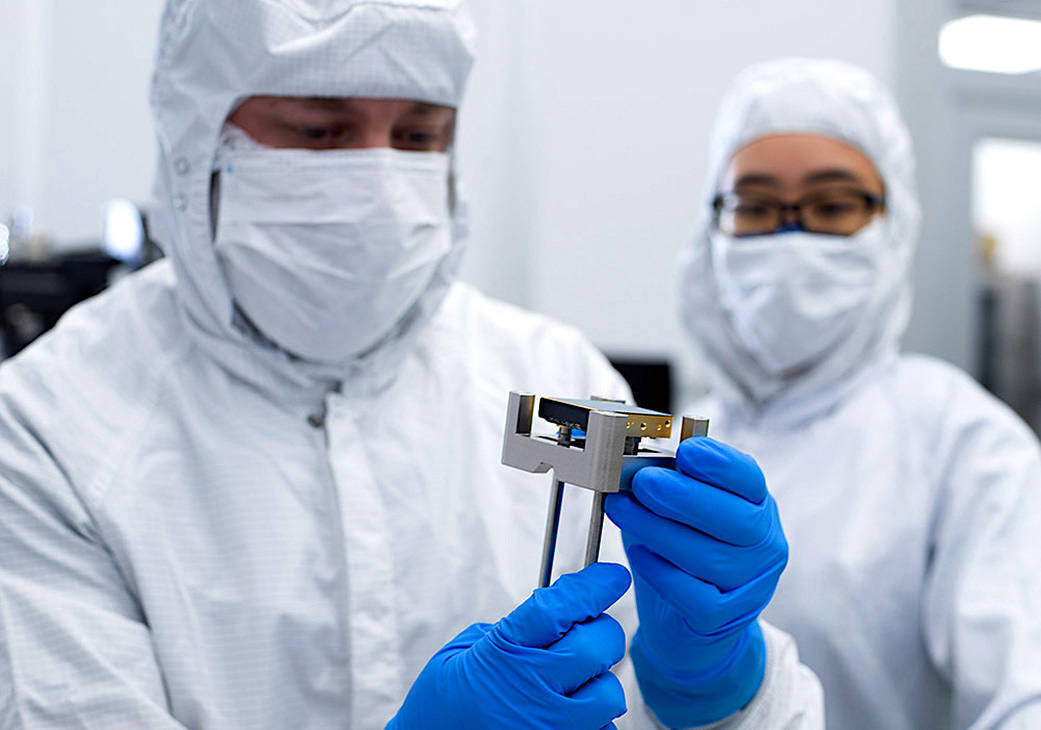
Billy Keim, a NASA technician, removes a 16-megapixel detector from its shipping container internal fixture as engineer Stephanie Cheung coordinates the activity. NASA’s future Nancy Grace Roman Space Telescope will be fitted with 18 of these infrared detectors, which have now been flight-approved. The Roman team possesses extra detectors that will be used for other purposes. The team reserved six of the surplus detectors to serve as flight-quality backups and several more for testing. Additional spare detectors may serve as the eyes of other telescopes with more lenient quality requirements.
Roman has delivered four detectors to be used in the 64-megapixel camera in Japan's Prime-focus Infrared Microlensing Experiment (PRIME) telescope, located in the South African Astronomical Observatory in Sutherland. The detectors are contributed as part of an international agreement between NASA and the Japan Aerospace Exploration Agency (JAXA). This telescope, which will be commissioned this fall, will hunt for exoplanets – worlds beyond our solar system – using the microlensing method. Roman scientists will use the results of this precursor survey to inform their observing strategy, maximizing the number of planets the mission will find. Experience using detectors like the ones in Roman will help scientists prepare their data analysis methods to capitalize on Roman’s enormous data volume after it launches no later than May 2027.
Quelle: NASA
----
Update: 18.05.2023
.
NASA Completes Heart of Roman Space Telescope’s Primary Instrument
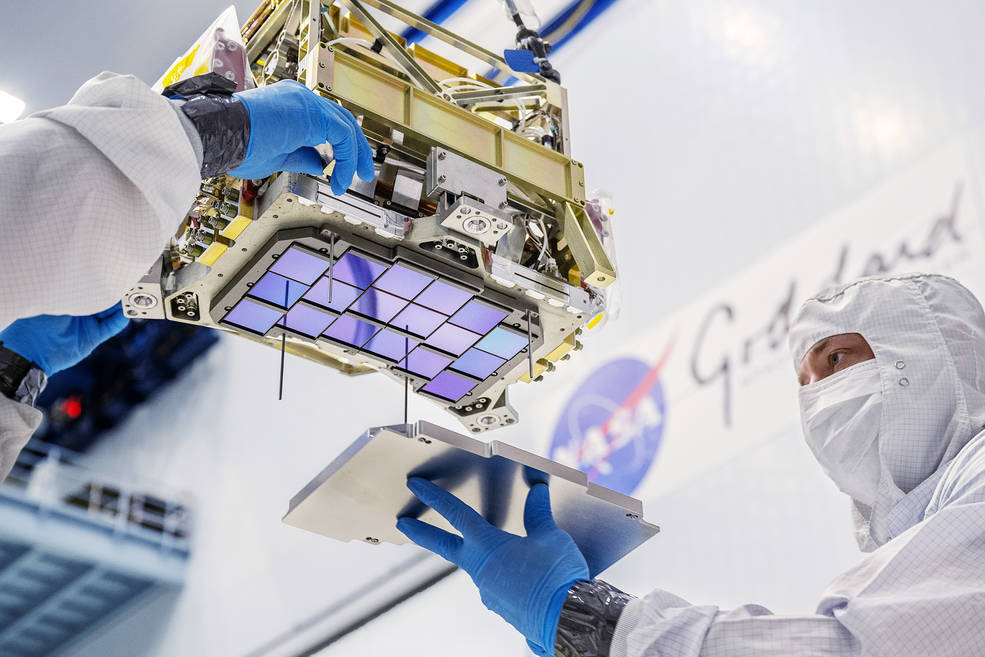
The heart of NASA’s Nancy Grace Roman Space Telescope was recently delivered to Ball Aerospace in Boulder, Colorado, for integration into the WFI (Wide Field Instrument). Called the FPS (Focal Plane System), it serves as the core of Roman’s camera. When the mission launches by May 2027, astronomers will use this system to gather exquisite images to help unravel the secrets of dark energy and dark matter, discover exoplanets, and explore many topics in infrared astrophysics.
The FPS is made up of a large detector array and its associated electronics. The detectors were developed by engineers at NASA’s Goddard Space Flight Center in Greenbelt, Maryland, and Teledyne Scientific & Imaging in Camarillo, California. The Goddard team also developed the electronics and assembled the FPS. Each of Roman’s 18 detectors has 16.8 million tiny pixels, which will provide the mission with remarkable image resolution. Through these “eyes,” we will be able to peer through dust and across vast stretches of the cosmos, creating high-resolution panoramas of the universe.
“Roman’s focal plane array is one of the biggest that has ever flown onboard a space-based observatory,” said Mary Walker, the Roman WFI manager at Goddard. “Its creation is the product of many years of innovation from a very dedicated team – one that is eagerly anticipating the incredible science Roman will yield.”
Once the FPS is installed in the spacecraft’s WFI – its camera – technicians will continue the build by integrating the instrument’s radiators.
“For optimal performance, the detectors must be operated at minus 288 degrees Fahrenheit, or minus 178 degrees Celsius,” said Greg Mosby, a research astrophysicist and Roman detector scientist at Goddard. “Roman’s detectors are so sensitive that nearby components in the Wide Field Instrument must also be cooled, otherwise their heat would saturate the detectors, effectively blinding the observatory.” The radiators will redirect waste heat from the instrument’s components away from the detectors out into cold space, ensuring that Roman will be sensitive to faint signals from distant galaxies and other cosmic objects.
After the radiators are installed, Roman’s camera will be complete and ready for thermal vacuum tests this summer. The team expects the entire WFI to return to Goddard in spring of 2024, where it will ultimately be integrated into the rest of the observatory.
Quelle: NASA
----
Update: 21.07.2023
.
New Study Reveals NASA’s Roman Could Find 400 Earth-Mass Rogue Planets

New research by scientists from NASA and Japan’s Osaka University suggests that rogue planets – worlds that drift through space untethered to a star – far outnumber planets that orbit stars. The results imply that NASA’s Nancy Grace Roman Space Telescope, set to launch by May 2027, could find a staggering 400 Earth-mass rogue worlds. Indeed, this new study has already identified one such candidate.
“We estimate that our galaxy is home to 20 times more rogue planets than stars – trillions of worlds wandering alone,” said David Bennett, a senior research scientist at NASA’s Goddard Space Flight Center in Greenbelt, Maryland, and a co-author of two papers describing the results. “This is the first measurement of the number of rogue planets in the galaxy that is sensitive to planets less massive than Earth.”
The team’s findings stem from a nine-year survey called MOA (Microlensing Observations in Astrophysics), conducted at the Mount John University Observatory in New Zealand. Microlensing events occur when an object such as a star or planet comes into near-perfect alignment with an unrelated background star from our vantage point. Because anything with mass warps the fabric of space-time, light from the distant star bends around the nearer object as it passes close by. The nearer object acts as a natural lens, creating a brief spike in the brightness of the background star’s light that gives astronomers clues about the intervening object that they can’t get any other way.
“Microlensing is the only way we can find objects like low-mass free-floating planets and even primordial black holes,” said Takahiro Sumi, a professor at Osaka University, and lead author of the paper with a new estimate of our galaxy’s rogue planets. “It’s very exciting to use gravity to discover objects we could never hope to see directly.”
The roughly Earth-mass rogue planet the team found marks the second discovery of its kind. The paper describing the finding will appear in a future issue of The Astronomical Journal. A second paper, which presents a demographic analysis that concludes that rogue planets are six times more abundant than worlds that orbit stars in our galaxy, will be published in the same journal.
Pint-Sized Planets
In only a few decades, we've gone from wondering whether the worlds in our solar system are alone in the cosmos to discovering more than 5,300 planets outside our solar system. The vast majority of these newfound worlds are either huge, extremely close to their host star, or both. By contrast, the team’s results suggest that rogue planets tend to be on the petite side.
“We found that Earth-size rogues are more common than more massive ones,” Sumi said. “The difference in star-bound and free-floating planets’ average masses holds a key to understanding planetary formation mechanisms.”
World-building can be chaotic, with all of the forming celestial bodies gravitationally interacting as they settle into their orbits. Planetary lightweights aren’t tethered as strongly to their star, so some of these interactions end up flinging such worlds off into space. So begins a solitary existence, hidden amongst the shadows between stars.
In one of the early episodes of the original Star Trek series, the crew encounters one such lone planet amid a so-called star desert. They were surprised to ultimately find Gothos, the starless planet, habitable. While such a world may be plausible, the team emphasizes that the newly detected “rogue Earth” probably doesn’t share many other characteristics with Earth beyond a similar mass.
Roman’s Hunt for Hidden Worlds
Microlensing events that reveal solitary planets are extraordinarily rare, so one key to finding more is to cast a wider net. That’s just what Roman will do when it launches by May 2027.
“Roman will be sensitive to even lower-mass rogue planets since it will observe from space,” said Naoki Koshimoto, who led the paper announcing the detection of a candidate terrestrial-mass rogue world. Now an assistant professor at Osaka University, he conducted this research at Goddard. “The combination of Roman’s wide view and sharp vision will allow us to study the objects it finds in more detail than we can do using only ground-based telescopes, which is a thrilling prospect.”
Previous best estimates, based on planets found orbiting stars, suggested Roman would spot 50 terrestrial-mass rogue worlds. These new results suggest it could actually find about 400, though we’ll have to wait until Roman begins scanning the skies to make more certain predictions. Scientists will couple Roman’s future data with ground-based observations from facilities such as Japan's PRIME (Prime-focus Infrared Microlensing Experiment) telescope, located at the South African Astronomical Observatory in Sutherland. This 1.8-meter telescope will build on MOA’s work by conducting the first wide-area microlensing survey in near-infrared light. It’s equipped with four detectors from Roman’s detector development program, contributed by NASA as part of an international agreement with JAXA (Japan Aerospace Exploration Agency).
Each microlensing event is a one-time occurrence, meaning astronomers can’t go back and repeat the observations once they’re over. But they’re not instantaneous.
“A microlensing signal from a rogue planet can take from a few hours up to about a day, so astronomers will have a chance to do simultaneous observations with Roman and PRIME,” Koshimoto said.
Seeing them from both Earth and Roman’s location a million miles away will help scientists measure the masses of rogue planets much more accurately than ever before, deepening our understanding of the worlds that grace our galaxy.
The Nancy Grace Roman Space Telescope is managed at NASA’s Goddard Space Flight Center in Greenbelt, Maryland, with participation by NASA's Jet Propulsion Laboratory and Caltech/IPAC in Southern California, the Space Telescope Science Institute in Baltimore, and a science team comprising scientists from various research institutions. The primary industrial partners are Ball Aerospace and Technologies Corporation in Boulder, Colorado; L3Harris Technologies in Melbourne, Florida; and Teledyne Scientific & Imaging in Thousand Oaks, California.
Quelle: NASA
----
Update: 25.08.2023
.
NASA Begins Integrating ‘Nervous System’ for Roman Space Telescope
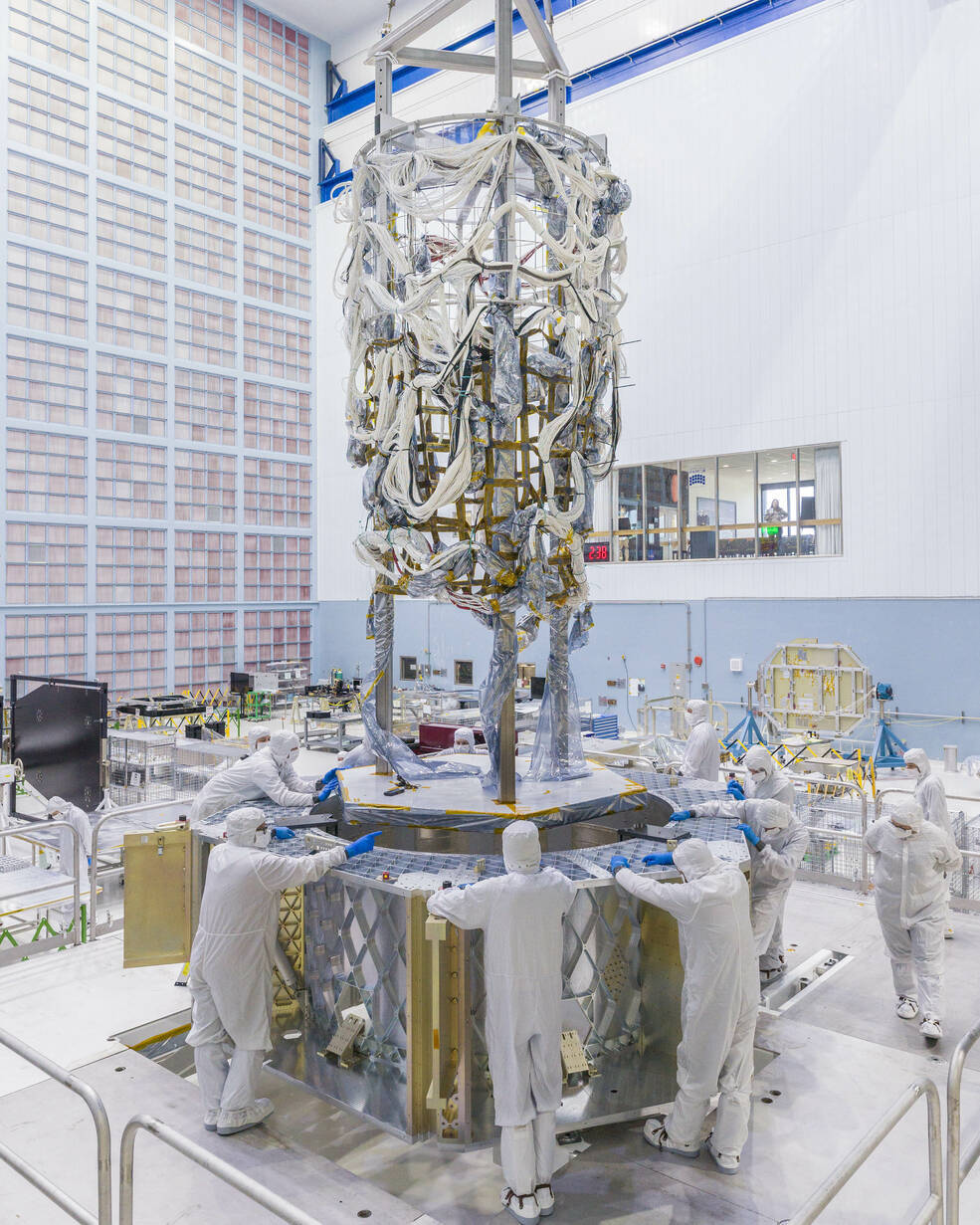
NASA’s Nancy Grace Roman Space Telescope team has begun integrating and testing the spacecraft’s electrical cabling, or harness, which enables different parts of the observatory to communicate with one another. Additionally, the harness provides power and helps the central computer monitor the observatory’s function via an array of sensors. This brings the mission a step closer to surveying billions of cosmic objects and untangling mysteries like dark energy following its launch by May 2027.
“Just as the nervous system carries signals throughout the human body, Roman’s harness connects its components, providing both power and commands to each electronic box and instrument,” said Deneen Ferro, the Roman harness project development lead at NASA’s Goddard Space Flight Center in Greenbelt, Maryland. “Without a harness, there is no spacecraft.”
Weighing around 1,000 pounds, the harness is made up of approximately 32,000 wires and 900 connectors. If the wires were laid out end-to-end, they would span 45 miles. Directed upward, they would reach eight times higher than the peak of Mount Everest.
Achieving this milestone was no small task. Over the course of about two years, a team of 11 Goddard technicians spent time at the workbench and perched on ladders, cutting wire to length, meticulously cleaning each component, and repeatedly connecting everything together.
The entire harness was built on an observatory mock-up structure before being transported to Goddard’s Space Environment Simulator – a massive thermal vacuum chamber used in this case for “bakeout.” When observatories like Roman are sent to space, the resulting vacuum and orbital temperatures can cause certain materials to release harmful vapors, which can then condense within electronics and create problems like short circuits or deposits on sensitive optics, degrading the telescope’s performance. Bakeout releases these gases on Earth so they aren’t emitted inside the spacecraft when in space.
Now, engineers will weave the harness through the flight structure in Goddard’s big clean room. This ongoing process will continue until most of the spacecraft components are assembled. In the meantime, the Goddard team will soon begin installing electronics boxes that will eventually provide power via the harness to all the spacecraft’s science instruments.
Quelle: NASA
----
Update: 15.09.2023
.
Primary Instrument for NASA’s Roman Completed, Begins Tests
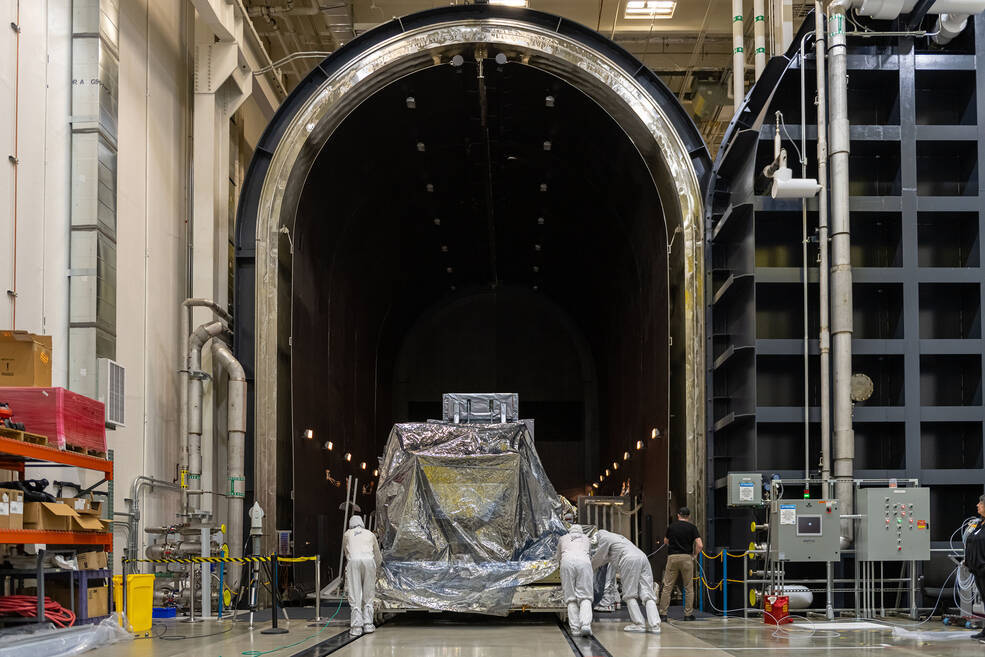
A team of engineers and technicians at Ball Aerospace, one of the industry partners for NASA’s Nancy Grace Roman Space Telescope, and NASA’s Goddard Space Flight Center in Greenbelt, Maryland, have finished assembling the spacecraft’s giant camera. Called the Wide Field Instrument (WFI), this state-of-the-art tool will enable astronomers to explore the cosmos from the outskirts of our solar system to the edge of the observable universe.

“The year-long integration effort culminates in the instrument’s first baseline performance testing, where we turn on the instrument to ensure it’s working as expected,” said Mary Walker, Roman’s WFI instrument manager at Goddard. “Now the team is ready to take the instrument through key environmental testing to show it can withstand the harsh conditions of launch and in space.”
The Ball team provided four components for the WFI: the stable optical structure, element wheel assembly, thermal management system, and alignment compensation mechanism. The Goddard team provided the critical optical elements, focal plane system, relative calibration system, and the instrument command and data handling electronics. Then engineers from both teams put all these building blocks together in a clean room in Boulder, Colorado, mechanically and electrically integrating the components into one system. Now, the team will complete full environmental testing in space-like conditions before delivering the WFI to Goddard in summer 2024. Once there, it will join other observatory systems for integration and testing, as the mission gets ready to launch no later than May 2027.
The WFI is a 288-megapixel infrared camera that will give Roman the same angular resolution as the Hubble Space Telescope but with at least 100 times Hubble’s field of view. Its sweeping cosmic surveys will help scientists discover new and uniquely detailed information about planets beyond our solar system, untangle mysteries like dark energy, and map how matter is structured and distributed throughout the cosmos. The mission’s broad, crisp view will produce an extraordinary resource for a wide range of additional investigations.
“Overall, Roman’s camera greatly exceeds the mission’s performance requirements, including the operational capabilities of the camera detectors,” said Julie McEnery, Roman’s project scientist at Goddard. “So now we get to explore how much better Roman’s surveys will be, and what we’ll be able to do with the extra scientific riches they produce.”
Quelle: NASA


